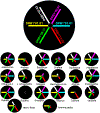In silico Analysis of the Binding Affinities of Antigenic Epitopes of Vaccines Administered to Gulf War Veterans to Specific HLA Class II Alleles Protective for Gulf War Illness
- PMID: 40746427
- PMCID: PMC12311970
- DOI: 10.29245/2572.942x/2019/5.1254
In silico Analysis of the Binding Affinities of Antigenic Epitopes of Vaccines Administered to Gulf War Veterans to Specific HLA Class II Alleles Protective for Gulf War Illness
Abstract
Gulf War Illness (GWI) is a chronic, multi-symptom disorder of unknown etiology affecting veterans of the 1990-91 Gulf War. We identified previously1 a set of 6 Human Leukocyte Antigen (HLA) class II alleles that are protective for GWI, namely DPB1*01:01, DPB1*06:01, DQB1*02:02, DRB1*01:01, DRB1*08:11, and DRB1*13:02. Since the function of HLA class II molecules is to connect with matching extracellular antigens of various pathogens (mostly viruses), as an initial step in the sequence of events leading to the development of antibodies against the matched antigen and its subsequent elimination, we hypothesized that GWI may be due, in part, to the persistence of offending antigens which could not be eliminated2,3. We further hypothesized4,5 that such antigens were contained in the 16 vaccines administered to GW veterans against adenovirus, anthrax, botulinum, cholera, diphtheria, hepatitis B, influenza A, Japanese encephalitis, measles, meningococcus, poliomyelitis, rabies, smallpox, tetanus, typhoid, yellow fever.6 This hypothesis predicts that antigens present in those vaccines should have a high affinity for matching with the 6 HLA class II protective alleles above. Here we tested this prediction by using the Immune Epitope DataBase (IEDB7) to determine the ranked affinity of each one of the 6 GWI protective alleles to the 10 most frequently assayed epitopes of each pathogen for which a vaccine was administered. We found that our 6 GWI protective alleles above collectively covered all vaccine antigens except for rubella for which all alleles above showed low binding affinity. Affinity strength varied among antigen-allele pairs, with DRB1*01:01 and DRB1*13:02 showing overall higher affinities. These two alleles also had the highest binding affinities for the anthrax antigen contained in the anthrax vaccine administered to GW veterans. These findings document a good match between the 6 GWI HLA protective alleles above and the antigens contained in the GW vaccines, and support the fundamental assumption that the HLA protection for GWI is mediated through the successful elimination of potentially harmful persistent antigens contained in those vaccines.
Keywords: Gulf War Illness (GWI); HLA epitope affinity; Human Leukocyte Antigen (HLA); immunity; persistent antigens; vaccines.
Figures








Similar articles
-
Anthrax and Gulf War Illness (GWI): Evidence for the Presence of Harmful Anthrax Antigen PA63 In the Serum of Veterans with GWI.J Neurol Neuromedicine. 2019 Nov 25;4(6):1-9. doi: 10.29245/2572.942x/2019/6.1255. J Neurol Neuromedicine. 2019. PMID: 40747435 Free PMC article.
-
Longitudinal Assessment of Ocular Biomarkers in Individuals With Gulf War Illness Symptoms.Mil Med. 2025 Jun 30;190(7-8):e1670-e1678. doi: 10.1093/milmed/usae457. Mil Med. 2025. PMID: 39361156 Free PMC article.
-
Genetic association between the APOE ε4 allele, toxicant exposures and Gulf war illness diagnosis.Environ Health. 2023 Jul 6;22(1):51. doi: 10.1186/s12940-023-01002-w. Environ Health. 2023. PMID: 37415220 Free PMC article.
-
Signs and symptoms to determine if a patient presenting in primary care or hospital outpatient settings has COVID-19.Cochrane Database Syst Rev. 2022 May 20;5(5):CD013665. doi: 10.1002/14651858.CD013665.pub3. Cochrane Database Syst Rev. 2022. PMID: 35593186 Free PMC article.
-
Systemic treatments for metastatic cutaneous melanoma.Cochrane Database Syst Rev. 2018 Feb 6;2(2):CD011123. doi: 10.1002/14651858.CD011123.pub2. Cochrane Database Syst Rev. 2018. PMID: 29405038 Free PMC article.
Cited by
-
C-Reactive Protein is Associated with Brain White Matter Anomalies in Gulf War Illness.J Neurol Neuromedicine. 2020 Oct 1;5(3):55-62. doi: 10.29245/2572.942x/2020/3.1276. J Neurol Neuromedicine. 2020. PMID: 40746877 Free PMC article.
References
Grants and funding
LinkOut - more resources
Full Text Sources
Research Materials
